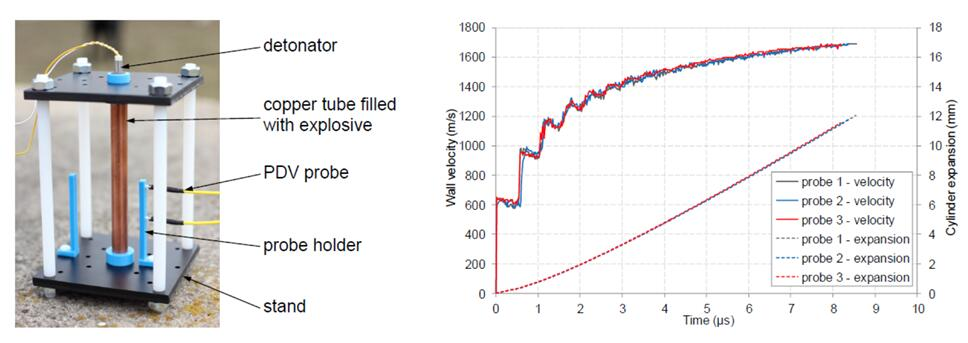Photonic Doppler Velocimeter

Photonic Doppler velocimetry had been developed before 2005 in the USA. Since that time PDV has gained a lot of attention and its usage has spread within several countries including, China, France, Russia,United Kingdom, and Czech Republic. The photonic Doppler velocimeter (PDV) allows measuring velocity profiles (velocity-time dependencies) of moving objects with high time resolution of up to 5 ns and accuracy of the measured velocity of about 0.1-0.5 %.
In recent years various uses of PDV have been tested and evaluated at the Institute of Energetic Materials,University of Pardubice. Three different PDV instruments have been employed in testing of the PDV application possibilities: single channel prototype PDV, four-channel custom made PDV and at the end,commercial four-channel Optimex-PDV (OZM Research). The voltage signals were recorded using a high bandwidth oscilloscope. The oscilloscope records were analyzed using short-time Fourier transform (STFT) with a Hamming window. The use of PDV for various applications is reviewed in this contribution.
Cylinder expansion test
The PDV instrumentation is superior compared to the outdated methods of wall expansion tracking by electric contact pins or streak cameras in view of accuracy, resolution and simplicity of operation. Characteristic Gurney velocity can be obtained from this experiment as well as the JWL equation of state constants of the detonation products.

Falling hammer impact
The falling hammer behaviour was observed at the moment of impact on a high explosive sample. PDV probe recorded velocity of the hammer directly before the moment of impact on the sample which exhibits as a short velocity drop to a zero value. Various types of reflected hammer velocity profiles were obtained for different explosives and depending on type of the explosive and mechanism of its initiation

Spalling of blast loaded concrete slab
A reinforced concrete slab subjected to detonation of a high explosive charge placed above it to simulate a terrorist attack. A large spall fracture occurred on the soffit of the slab and the spalled material was accelerated towards the PDV probe which was able to capture the spall movement including its early stages. The resulting velocity profile provides input data for numerical modelling of blast response of the material

Cladder plate tracking in explosion welding
Explosion welding allows to weld practically any combination of metallic materials with excellent joint quality. However, parameters of the explosive and spatial relations of all the parts must be adjusted correctly. The probe aimed against the cladder plate allows to determine the whole velocity profile of the plate including its terminal velocity at which the impact with the base plate occurs. The PDV proved to be applicable even in a full scale open field explosion welding

